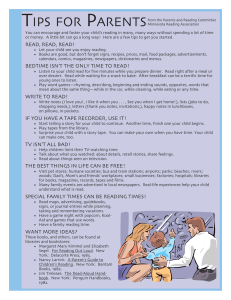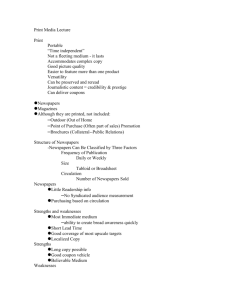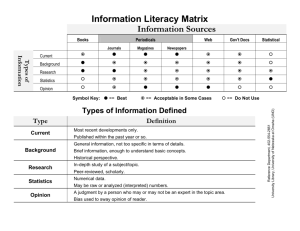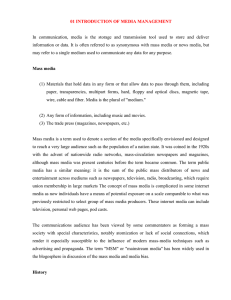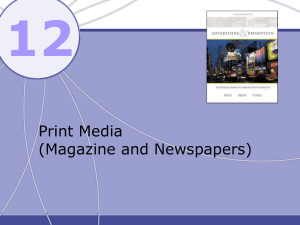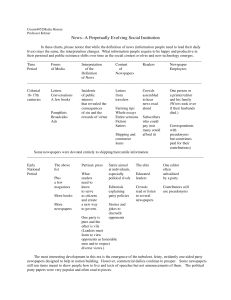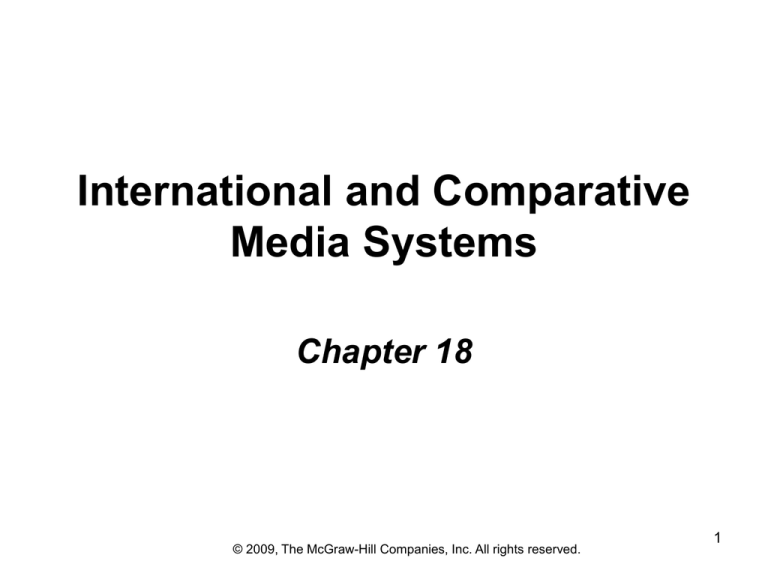
International and Comparative
Media Systems
Chapter 18
© 2009, The McGraw-Hill Companies, Inc. All rights reserved.
1
CHAPTER OUTLINE
•
•
•
•
International Media Systems
World Media Online
Comparative Media Systems
Examples of Other Systems
2
INTERNATIONAL MEDIA SYSTEMS
• Mass media can cross national boundaries
– Simple spillover of media
– Designed deliberately for other countries
3
Global Print Media
• Many major newspapers provide foreignlanguage or international editions
– General newspapers
– Financial newspapers
• Global wire services dominate the
international flow of news
• International distribution of magazines
4
Global Broadcasting
• About 150 countries engage in
international broadcasting
• Top five global broadcast leaders are
– World Service of the BBC; Voice of America
(VOA); China Radio International; Deutsche
Welle (DW; German Wave); Radio France
International (RFI)
• Proliferation of global news, sports, and
music channels
5
Film and TV
• American films dominate many foreign box
offices
– Foreign box office accounts for more than half a film’s
revenue
– International DVD revenue is important
• US dominates international TV program market
– Local programs provide strong competition, and
dominate prime time in many countries
– Format licensing
• TV signals ignore international boundaries
– Lost international revenues; cultural domination
6
WORLD MEDIA ONLINE
• The Internet provides access to worldwide
media
– Radio stations
– Streaming video
– Major newspapers & magazines
• Information also contained in e-mail,
newsgroups, individual web sites
• Limited use of WWW: In 2006, about 16% of
world’s population was online, mostly in
developed countries
7
COMPARATIVE MEDIA SYSTEMS
• The political system of a country usually
determines the relationship between the
media, the government, and the people
8
Theories of the Press
•
•
•
•
•
Authoritarian Theory
Libertarian Theory
Social Responsibility Theory
Communist Theory
Developmental Theory
9
Control and Ownership of the
Media
• Media systems can be classified along
dimensions of control and ownership.
– Public ownership, decentralized control
– Public ownership, centralized control
– Private ownership, decentralized control
– Private ownership, centralized control
10
Role of the Media in Various
Countries
• The role of the mass media differs
according to its ownership and control
• Biggest differences across the different
levels of ownership/control are found in
the interpretation, or editorial, function
11
Economic Differences
• US media largely supported by advertising
• Many Western European countries provide
subsidies to media
• Developmental media systems get a mix
of private and governmental funding
• Communist media get most of their
funding from the government, but
advertising revenue is welcomed
12
EXAMPLES OF OTHER
SYSTEMS
• We will explore three media systems
13
Japan
• Literacy rate near 100%
• Strong print tradition: 10 papers exceed 1 million daily
circulation
– Competition from new technology
•
•
•
•
•
•
•
News and business magazines
Broadcast system modeled after British
Commercial networks started after WW II
Pioneers in HDTV & DBS
American films dominate box office
Cell phone use high
Internet use 71%
14
Mexico
• Striving to form indigenous media system
• Literacy rate 92%
• 300 daily newspapers, combined circulation about 9
million
• 200 magazines
• Government has controlled media; system is called
“partly free”
• Broadcasting influenced by US system
• Top-rated TV shows are generally Mexican productions
• Significant media content flow to US
15
China
• With some exceptions, the trend has been toward less
government control, and more diverse media landscape
• 200 newspapers; combined circulation about 200 million
• 10,000 magazines
• 650 radio stations reach 95% of population
• TV penetration 90%
• Limits on imports and foreign news
• Internet penetration 11%; controls over access to web
sites
• Mobile media becoming popular
16

